What is Aush? (Meaning, History, Varieties of Persian Aush)
One of Iran’s most famous dishes is Aush or Ash. This authentic Persian food is usually cooked with various ingredients, mostly vegetables and legumes. Aush is a completely Iranian food that was later loaned from Iran to other parts of the world, but definitely Aush is a completely Iranian food.
This delicious dish is very similar to soup. Aush has many different types with attractive and delicious flavors that differ from city to city in Iran.
This delicious food is very delicious and popular not only in Iran but also for tourists who travel to Iran. In the following, we will introduce the types of dishes, history, cooking methods, and everything related to the charms of this delicious food.
Aush History
This iconic Persian dish finds its roots in ancient times, with some accounts tracing it to the Sassanian Empire, which ruled Iran from the 3rd to the 7th century AD.
Aush was originally a humble peasant food that arose due to the need for sustenance in a challenging agricultural environment.
It was a clever combination of locally available ingredients, such as legumes, vegetables, and Persian herbs, often enjoyed in the colder months for their warmth and nutritional value.
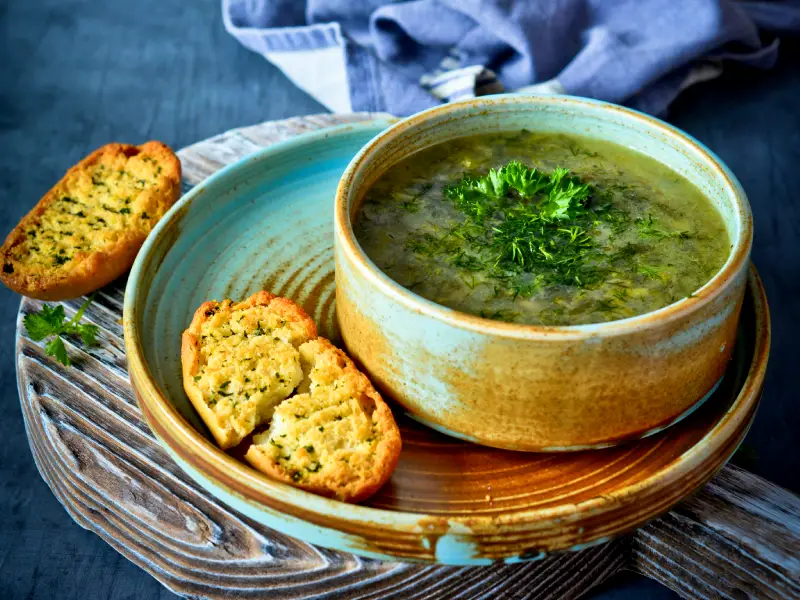
As time passed, Aush transcended its origins and evolved into a basic and main dish in Iranian cuisine. Its significance extends beyond the realm of gastronomy and holds a special place in Iranian culture.
Aush is more than just food; it’s a symbol of hospitality and togetherness. In Iranian households, preparing Aush is often a communal activity, with family members coming together to chop vegetables, share stories, and bond over the stove.
Moreover, Aush plays a prominent role in Iranian celebrations and gatherings, with variations like Aush Reshteh taking center stage during Nowruz, the Persian New Year.
Aush Meaning
The term “Aush” holds a deep-rooted linguistic heritage, tracing its origins to the Sanskrit language. “Aush” refers to a type of watery food prepared from legumes, oil, vegetables, and similar ingredients.
The name itself is linguistically tied to the act of sipping or consuming, as “Aush” is indeed a fluid-based dish. This etymology provides a glimpse of the historical and cultural importance of this dish in the culinary landscape of Iran.
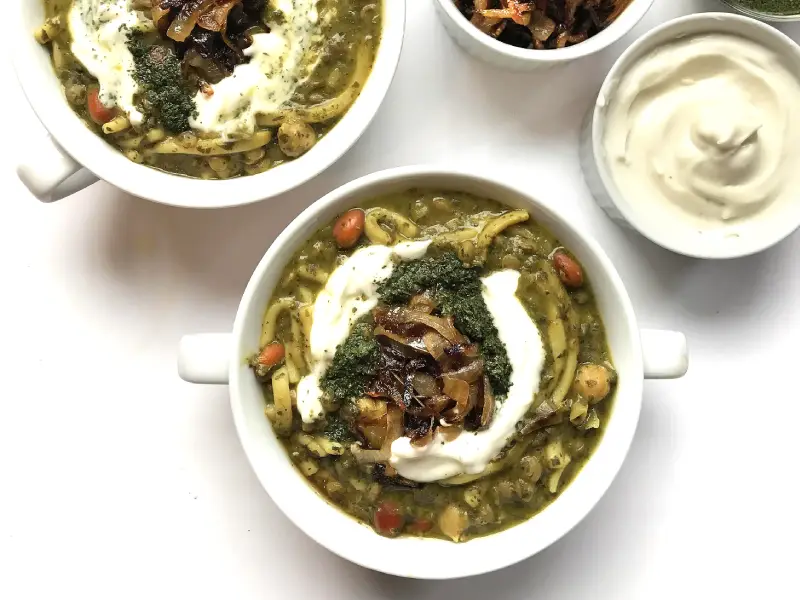
The influence of “Aush” extends beyond the dining table, reaching into the realm of language itself. From the term “Aush,” we find the derivation of words like “Aushpaz” (cook) and “Aushpazkhaneh” (kitchen), highlighting the integral role that this food has played in shaping the language and culture of Iran.
It is proof of the presence and enduring importance of aush in Iranian society, where it is not only a cherished food but also a source of inspiration for the language and culinary traditions.
Nutritional Value of Aush
Aush is not just delicious; it is also quite nutritious and packed with vitamins, fiber, and protein, making it a healthy choice.
The legumes in Aush, like chickpeas and lentils, give you a good dose of protein and fiber, which helps your body stay strong and your tummy feel full. Plus, all those colorful vegetables and herbs add vitamins and minerals that are great for your health.
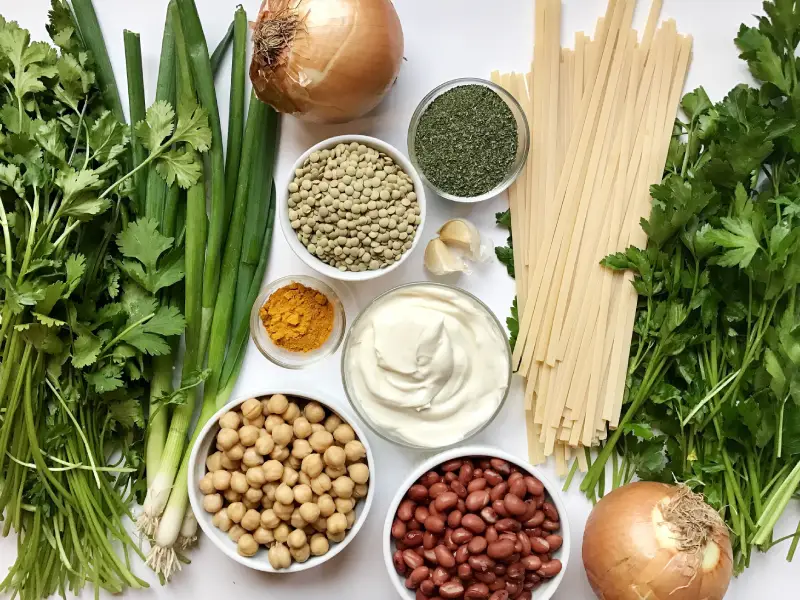
Aush also comes with some health perks. Aush is often full of greens like spinach and herbs like mint and parsley, which are good for digestion and can help you stay feeling fresh.
The spices used in Aush, like turmeric and cumin, do not just make it flavorful; they may also have some anti-inflammatory properties.
Difference Between Aush and Soup
Aush and soup are both warm and tasty dishes, but they have some differences. One big difference is the thickness. Aush is usually thicker than soup.
It is kind of like a stew with lots of delicious ingredients, like vegetables, legumes, and sometimes noodles or rice. Soup, on the other hand, is often more watery and has fewer ingredients floating in it.
So, if you like a heartier, thicker meal, Aush might be your pick.
Another difference is where they come from. Aush is very popular in Iranian cuisine and has many regional variations.
Iranians have been making Aush for a long time and have their own special recipes. Soup, on the other hand, is enjoyed all over the world, and different countries have their own types of soup, like chicken soup in the United States or miso soup in Japan. So, while Aush has its roots in Iran, soup is like a global food adventure with countless flavors to try.
Varieties of Aush
Aush Hearty Iranian food is offered in a wide range that is different according to regional tastes and preferences. This delightful collection of dishes reflects the richness and complexity of Iranian cuisine.
In the following, you will learn about some of the most popular types of Aush, each of which offers a unique combination of ingredients and flavors.
Ash-e doogh
Iran boasts a wide range of Aush dishes, each with its own unique ingredients and flavors. One popular variety is “Aush-e Doogh,” which is often associated with Ardabil but is also enjoyed in regions like Hamedan, Urmia, Qazvin, and Shiraz.

In Ardabil-style Aush-e Doogh, you will find plenty of garlic, tangy doogh (yogurt drink), mint, eggs, chickpeas, and half-cooked rice, creating a refreshing and hearty combination.
Meanwhile, Aush-e Doogh from Qazvin features black-eyed peas, oregano, rice, doogh, meat cubes, mint, sautéed onions, and a medley of spices.
Aush Reshteh
Aush Reshteh is one of the most famous traditional foods among Iranians. It is made from ingredients like lentils, beans, chickpeas, and various herbs such as tarragon, parsley, spinach, and cilantro.
Sometimes, they even add beet greens and noodles, all flavored with kashk (strained yogurt), vinegar, and lime juice.

Aush Reshteh is not only enjoyed in Iran but also prepared in other countries like Turkey and Armenia. In Turkey, they make a similar dish called “Aşure,” using lentils, onions, celery and tomatoes.
In Iran, there is a special version of Aush Reshteh known as “Aush-e Posht-e Pa,” which is cooked about 3 to 7 days after someone returns from a trip.
It is made to wish the traveler good health and to ease their journey. The cooking ceremony includes saying prayers, reciting blessings, and burning incense.
Aush Kashk
Aush Kashk is a traditional dish hailing from Kohgiluyeh and Boyer-Ahmad province. What makes Aush Kashk special is its simplicity in both preparation and ingredients.
It consists of kashk (strained yogurt), broken rice, mint, chickpeas, and various spices, creating a delightful blend of flavors and textures.
Aush-e Khore
Aush-e Khore, also known as Aush-e Kardan, is typically prepared in the Khuzestan, Fars, Kohgiluyeh, and Boyer-Ahmad regions.
It features a vegetable called Khore, which resembles cabbage. In this Aush, Khore is prepared alongside other herbs, creating a unique and refreshing taste.
Aush-e Shole Ghalamkar
Aush-e Shole Ghalamkar has a special place in Iranian history, with roots dating back to the Qajar era. During Naser al-Din Shah Qajar’s reign, this dish was cherished as one of his favorite meals.
Interestingly, the Shah used to make a pilgrimage to the northwestern outskirts of Tehran each year to fulfill his vow of preparing and enjoying Aush-e Shole Ghalamkar.

Legend has it that 12 pots of Aush-e Shole Ghalamkar, made from the finest freshly slaughtered lamb meat, along with other delicacies, were cooked throughout the morning to be ready for lunch.
The rich flavors of this dish, combining lamb meat, herbs, garlic, onions, and legumes, have earned it a reputation as one of the best-tasting Aush varieties.
Aush Aloo
Aush Aloo is a type of Aush that is commonly enjoyed in Iran. It combines rice, fresh plums, herbs like coriander and parsley, and tarragon. Some versions also include small meatballs made from lamb, calf, camel, or chicken.
Aush-e Jo
Aush Jo is another boundary-less Aush enjoyed in Iran. It has aromatic herbs like fenugreek, cilantro, and tarragon, along with legumes such as chickpeas, kidney beans, and cucumbers. Onions, kashk (strained yogurt), and dried mint add extra depth of flavor to this aromatic dish.
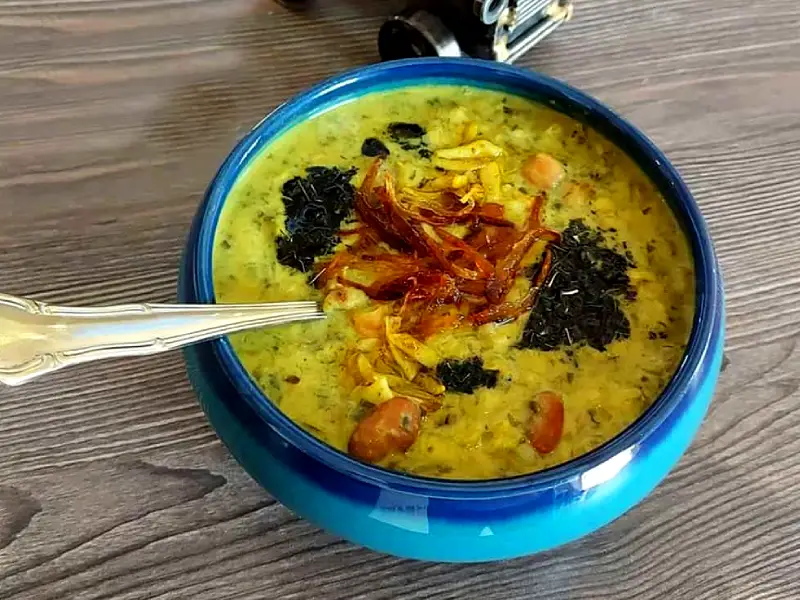
Aush Tarkhineh
Aush Tarkhineh is a beloved Aush that is popular across Iran. This delicious Aush is made by boiling cracked wheat in yogurt or milk, along with chickpeas, beans, spinach, and sour plums or cherries. To enhance the flavors, it is often served with grape syrup and vinegar.
Final Word
Aush, deeply rooted in Iranian culture, transcends being just a meal. It serves as a symbol of unity, tradition, and warm hospitality. Aush reflects the sense of togetherness and goodwill that defines Iranian society.
It is a dish that brings families and friends together around the table, where stories are shared and bonds are strengthened.
For travelers exploring Iran, tasting Aush is not only a culinary experience but also an introduction to Iranian culture. Trying different regional types of Aush allows visitors to discover the diversity of Iranian cuisine and the richness of its traditions.
Therefore, on your trip to Iran, be sure to try different Iranian Aushes in each city and learn more about Iranian culture and history.
Are you planning to travel to Iran and looking for an Iran resort? Consider Matinabad eco resort.

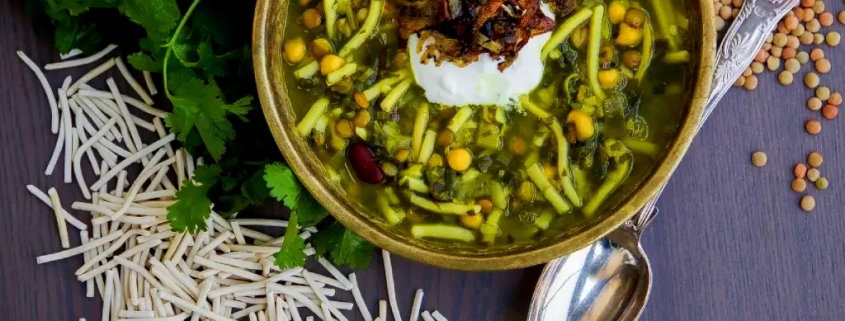



Leave a Reply
Want to join the discussion?Feel free to contribute!